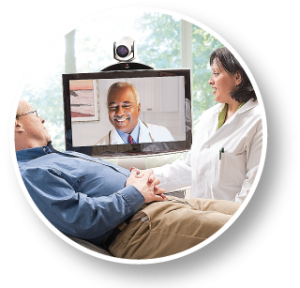TeleMedicine – Definition And Benefits
What Is Telemedicine
Telemedicine is a convenient way to see your doctor from your home or office via Skype,

What Is Telemedicine

Telemedicine is a convenient way to see your doctor from your home or office via Skype, Facetime, or other two- way video applications. Telemedicine includes a growing variety of applications and services using two-way video, email, smartphones, wireless tools and other forms of telecommunications technology. With telemedicine, you can see your physician from home and eliminate the hassle of traveling to the doctor’s office, waiting in the waiting room and exam room.
Starting out over 40 years ago with demonstrations of hospitals extending care to patients in remote areas, the use of telemedicine has spread rapidly and is now becoming integrated into the ongoing operations of hospitals, specialty departments, home health agencies, private physician offices as well as consumer’s homes and workplaces.
Telemedicine is not a separate medical specialty. Products and services related to telemedicine are often part of a larger investment by healthcare institutions in either information technology or the delivery of clinical care. Telemedicine and telehealth are interchangeable terms, encompassing a wide definition of remote healthcare. Patient consultations via video conferencing, transmission of still images, e-health including patient portals, remote monitoring of vital signs, continuing medical education, consumer-focused wireless applications, and nursing call centers, among other applications, are all considered part of telemedicine and telehealth.
Telemedicine refers to the actual delivery of remote clinical services using technology.
What Are The Benefits Of Telemedicine?
Telemedicine has been growing rapidly because it offers four fundamental benefits:
- Improved Access – For over 40 years, telemedicine has been used to bring healthcare services to patients in distant locations. Not only does telemedicine improve access to patients but it also allows physicians and health facilities to expand their reach, beyond their own offices. Given the provider shortages throughout the world–in both rural and urban areas–telemedicine has a unique capacity to increase service to millions of new patients.
- Cost Efficiencies – Reducing or containing the cost of healthcare is one of the most important reasons for funding and adopting telehealth technologies. Telemedicine has been shown to reduce the cost of healthcare and increase efficiency through better management of chronic diseases, shared health professional staffing, reduced travel times, and fewer or shorter hospital stays.
- Improved Quality – Studies have consistently shown that the quality of healthcare services delivered via telemedicine are as good those given in traditional in-person consultations. In some specialties, particularly in mental health and ICU care, telemedicine delivers a superior product, with greater outcomes and patient satisfaction.
- Patient Demand – Consumers want telemedicine. The greatest impact of telemedicine is on the patient, their family, and their community. Using telemedicine technologies reduces travel time and related stresses for the patient. Over the past 15 years, study after study has documented patient satisfaction and support for telemedical services. Such services offer patients access to providers that might not be available otherwise, as well as medical services without the need to travel long distances.
What Services Can Be Provided By Telemedicine?
Sometimes telemedicine is best understood in terms of the services provided and the mechanisms used to provide those services. Here are some examples:
- Primary care and specialist referral services may involve a primary care or allied health professional providing a consultation with a patient or a specialist assisting the primary care physician in rendering a diagnosis. This may involve the use of live interactive video or the use of store and forward transmission of diagnostic images, vital signs and/or video clips along with patient data for later review.
- Remote patient monitoring, including home telehealth, uses devices to remotely collect and send data to a home health agency or a remote diagnostic testing facility (RDTF) for interpretation. Such applications might include a specific vital sign, such as blood glucose or heart ECG or a variety of indicators for homebound patients. Such services can be used to supplement the use of visiting nurses.
- Consumer medical and health information includes the use of the Internet and wireless devices for consumers to obtain specialized health information and on-line discussion groups to provide peer-to-peer support.
- Medical education provides continuing medical education credits for health professionals and special medical education seminars for targeted groups in remote locations.
- What Delivery Mechanisms Can Be Used?
- Networked programs link tertiary care hospitals and clinics with outlying clinics and community health centers in rural or suburban areas. The links may use dedicated high-speed lines or the Internet for telecommunication links between sites. There are estimates that the number of existing telemedicine networks in the United States at roughly 200 providing connectivity to over 3,000 sites.
- Point-to-point connections using private high-speed networks are used by hospitals and clinics that deliver services directly or outsource specialty services to independent medical service providers. Such outsourced services include radiology, stroke assessment, mental health, and intensive care services.
- Monitoring center links are used for cardiac, pulmonary or fetal monitoring, home care and related services that provide care to patients in the home. Often normal land-line or wireless connections are used to communicate directly between the patient and the center although some systems use the Internet.
- Web-based e-health patient service sites provide direct consumer outreach and services over the Internet. Under telemedicine, these include those sites that provide direct patient care.